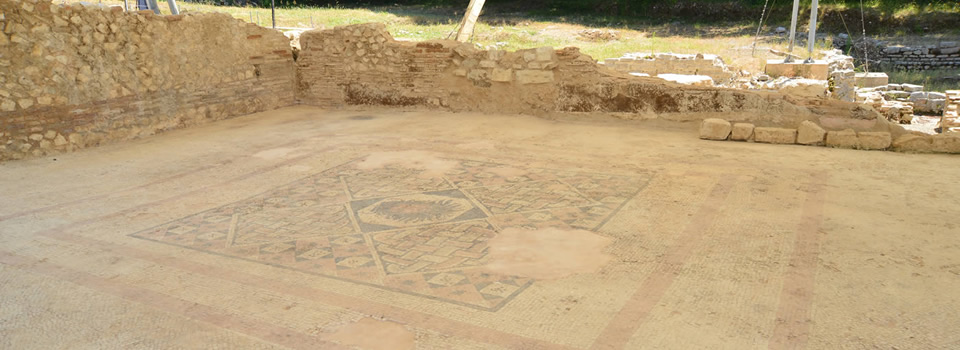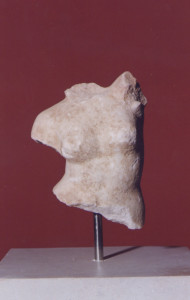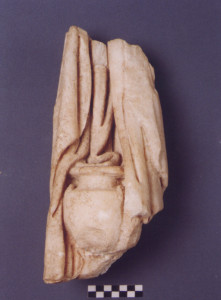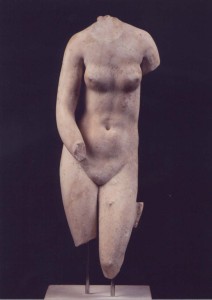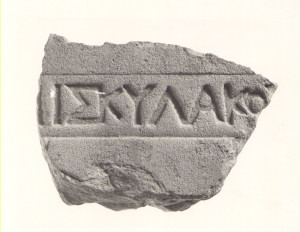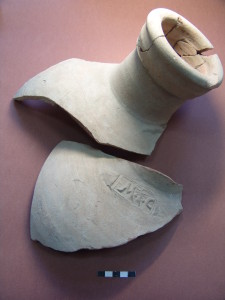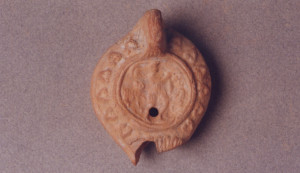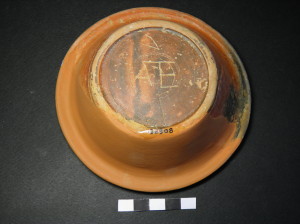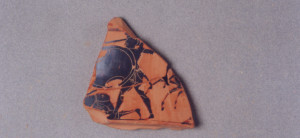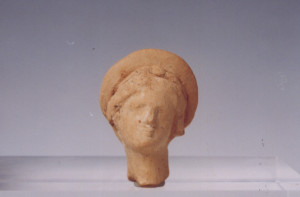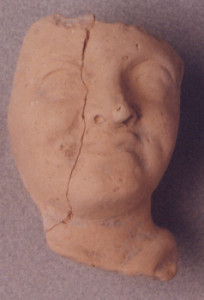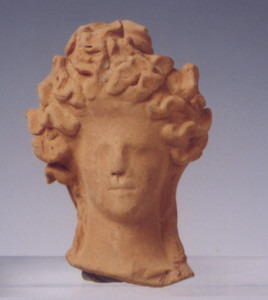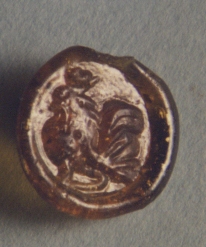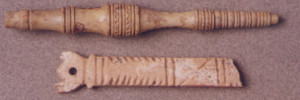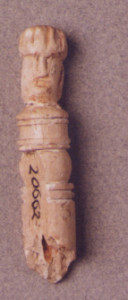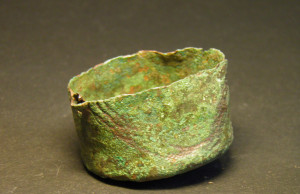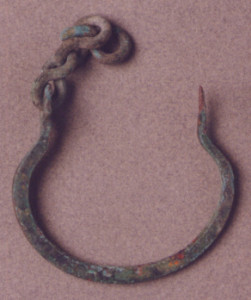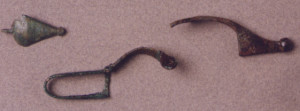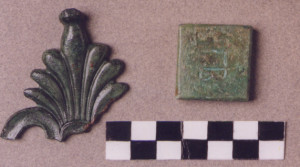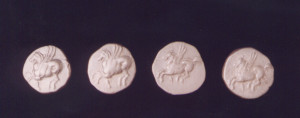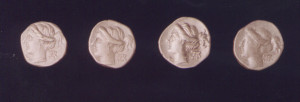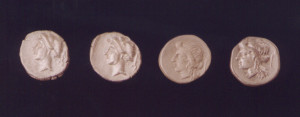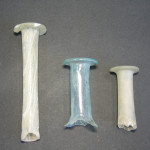THE FINDS FROM THE PALEOPOLIS EXCAVATIONS
Α. ROMAN BATHS PALAIOPOLIS
The excavations have brought to light significant art objects and everyday artifacts that allow us to understand the function of baths and the lifestyle of that era. Among these, sculptures, figurines, jewelry, bone and metal objects, inscribed tiles, ceramic and glass vessels as well as plenty of currencies are included.
SCULPTURE
During the excavations some statue fragments of the Roman period have come to light. From these finds, three marble fragments coming from Aphrodite statues stand out. One of them represents the torso of a naked Aphrodite which is preserved from the shoulders to the knees and showing intense rendering of the anatomical details of the chest and abdomen. It is a Roman copy dated to the 2nd century A.D. The presence of these objects is justified by the fact that the Roman baths carried a rich sculptural decoration (fig. 37-39).
- Μαρμάρινος κορμός γυμνής Αφροδίτης, ρωμαϊκό αντίγραφο, χώρος Ι. Μουσείο Παλαιόπολης-Mon Repos.
- Τμήμα μαρμάρινου αγάλματος Αφροδίτης τύπου «Κνίδου», ρωμαϊκό αντίγραφο, 2ος-3ος αι. μ.Χ., χώρος Ι. Μουσείο Παλαιόπολης-Mon Repos.
- Μαρμάρινος κορμός γυμνής Αφροδίτης, ρωμαϊκό αντίγραφο, 2ος αι. μ.Χ., χώρος V.
INSCRIBED ROOF TILES
During the excavations in the area of the baths, inscribed roof tiles coming from public buildings were found, bearing names of various prytanes (superior state officer) such as Skylax (prytanis of the 2nd or 1st century B.C.), Menestratos (prytanis of the 1st century B.C.). Some roof tiles with animal prints are also of interest.
- Τμήμα ενσφράγιστης κεράμου στέγης, 3ος-2ος αι. π.χ., χώρος Ι. Μουσείο Παλαιόπολης-Mon Repos.
- Τμήμα κεράμου στέγης με αποτύπωμα σκύλου.
POTTERY
Significant amounts of pottery derive from the area of the Roman baths, representing all phases of space use, starting from the 8th-7th century B.C. and reaching up to the 6th century, when the place was abandoned. The ceramic repertoire includes fragments of proto-corinthian vases, black and red figured sherds from Corinth, Attica and Laconia, Hellenistic sherds from the Peloponnese, central Italy and Athens or copies of local workshops, as well as a wide variety of Roman pots. Among the finds which include a wide variety of utilitarian vessels necessary for bathing and grooming, of major importance are the Roman relief lamps and bowls decorated with hunting and battle scenes, Dionysiac scenes or the labors of Hercules.
- Τμήμα αμφορέα, ρωμαϊκών χρόνων.
- Τμήμα λύχνου με ανάγλυφη παράσταση αιγόκερου 4ος-5ος αι. μ.Χ. και ρωμαϊκός λύχνος με ανάγλυφη διακόσμηση.
- Ακέραιο ρωμαϊκό λυχνάρι με ανάγλυφη παράσταση ερωτικής σκηνής, 2ος-4ος αι. μ.Χ., χώρος IVα, Μουσείο Παλαιόπολης-Mon Repos.
- Αβαθές πινάκιο του τύπου eastern sigilata. Φέρει εγχάρακτα τα αρχικά «ΑΕ». Ρωμαϊκής εποχής, πρώιμος 1ος – αρχές 2ου αι. μ.Χ.
- Όστρακο μελανόμορφου αγγείου με παράσταση πολεμικής σκηνής, χώρος ΙΙ, Μουσείο Παλαιόπολης-Mon Repos.
TERRACOTTA FIGURINES
During the excavations, fragments of figurines dating from the 7th century B.C. to the Roman era have been located. Among these, the head of a terracotta Aphrodite figurine dating around the end of the 4th century B.C. (early Hellenistic period) and a male head probably portraying a Roman emperor are distinguished.
- Κεφάλι πήλινου ειδωλίου Αφροδίτης, πρώιμα ελληνιστικά χρόνια, 4ος αι. π.χ., χώρος Ι.
- Τμήμα πήλινου ανδρικού ειδωλίου, πιθανώς πορτραίτο ρωμαίου αυτοκράτορα.
- Κεφάλι πήλινου γυναικείου ειδωλίου με περίτεχνη κόμμωση (λαμπάδιο), χώρος ΙΙ.
JEWELRY & BONE IMPLEMENTS
As the bath area is directly associated with grooming and body care, jewelry of various materials (such as copper and other metals, bone and semi-precious stones) as well as other objects, such as ornate hair pins and parts of mirrors were found.
- Σφράγισμα με πετεινό, 1ος-2ος αι. μ.Χ., Μουσείο Παλαιόπολης-Mon Repos.
- Στέλεχος κατόπτρου, 1ος αι. μ.Χ. / Στέλεχος μαχαιριδίου,1ος-4ος αι. μ.Χ., Μουσείο Παλαιόπολης-Mon Repos.
- Οστέινες βελόνες
METAL OBJECTS
During the excavations many metal objects, such as buckles, pins, copper weights, hooks, decorative fragments of bronze vessels and mirrors, lead loom weights, decorative sheets, nails, strigils as well as a pyxis were revealed.
- Τμήμα χάλκινης πυξίδας (κάλυμμα).
- Τμήμα χάλκινης αλυσίδας με άγκιστρο.
- Χάλκινο περίαπτο, χώρος ΙΙ, μέσοι αυτοκρατορικοί χρόνοι / Τμήμα χάλκινης πόρπης / Τμήμα χάλκινης πόρπης με εγχάρακτο γράμμα-χ-, 1ος-2ος αι. μ.Χ.
- Πλαστικό χάλκινο ανθέμιο που διακοσμούσε κάτοπτρο και εγχάρακτο μολύβδινο σταθμίο, που στο κέντρο της μιας επίπεδης επιφάνειας φέρει τα γράμματα «Γ, Β».
TREASURE OF SILVER COINS
During the excavation of 1995, south of the baths, a “treasure” of 508 silver drachmas of Corinth and Corfu dating from the end of the 4th and early 3rd century B.C. was discovered. Apart from this significant find, many silver coins among which a silver Corfiot stater and an Athenian drachma as well as a plethora of copper Corfiot coins of the Hellenistic and Roman periods were found on the premises.
- Νομίσματα από το «θησαυρό» των 508 αργυρών νομισμάτων.
GLASSWARE
During the excavations, a large variety of glass finds was retrieved. These artefacts are fragmentarily preserved and date from the 5th century B.C. to the 3rd century A.D. They represent various types of glassware, such as flasks, pitchers, jugs, perfume bottles, drinking vessels, small storage jars as well as fragments from the bath windows. The majority of these finds date from the 1st to the 2nd century A.D. and refer to undecorated ware. Some of these objects derive from the Eastern Mediterranean and are dated to the 5th century B.C.




